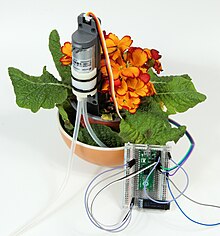
Back الزراعة الذكية Arabic Έξυπνη γεωργία Greek Agriculture numérique French Cendekiatani ID Ọrụ ugbo dijitalụ IG Akıllı tarım Turkish
This article is written like a personal reflection, personal essay, or argumentative essay that states a Wikipedia editor's personal feelings or presents an original argument about a topic. (February 2022) |

Digital agriculture, sometimes known as smart farming or e-agriculture,[1] are tools that digitally collect, store, analyze, and share electronic data and/or information in agriculture. The Food and Agriculture Organization of the United Nations has described the digitalization process of agriculture as the digital agricultural revolution.[2] Other definitions, such as those from the United Nations Project Breakthrough,[3] Cornell University,[4] and Purdue University,[5] also emphasize the role of digital technology in the optimization of food systems.
Digital agriculture includes (but is not limited to) precision agriculture. Unlike precision agriculture, digital agriculture impacts the entire agri-food value chain — before, during, and after on-farm production.[6] Therefore, on-farm technologies like yield mapping, GPS guidance systems, and variable-rate application, fall under the domain of precision agriculture and digital agriculture. On the other hand, digital technologies involved in e-commerce platforms, e-extension services, warehouse receipt systems, blockchain-enabled food traceability systems, tractor rental apps, etc. fall under the umbrella of digital agriculture but not precision agriculture.
- ^ "Technology and digital in agriculture - OECD". www.oecd.org. Retrieved 2019-07-25.
- ^ Trendov, Nikola M.; Varas, Samuel; Zeng, Meng. "Digital Technologies in Agriculture and Rural Areas" (PDF). Retrieved 17 October 2021.
- ^ "Digital Agriculture: feeding the future". Project Breakthrough. Retrieved 2019-07-25.
- ^ "Digital Agriculture". Cornell University. Retrieved 2019-07-25.
- ^ "Home". Purdue University Digital Agriculture. Retrieved 2019-07-25.
- ^ Shepherd, Mark; Turner, James A.; Small, Bruce; Wheeler, David (2018). "Priorities for science to overcome hurdles thwarting the full promise of the 'digital agriculture' revolution". Journal of the Science of Food and Agriculture. 100 (14): 5083–5092. doi:10.1002/jsfa.9346. PMC 7586842. PMID 30191570.